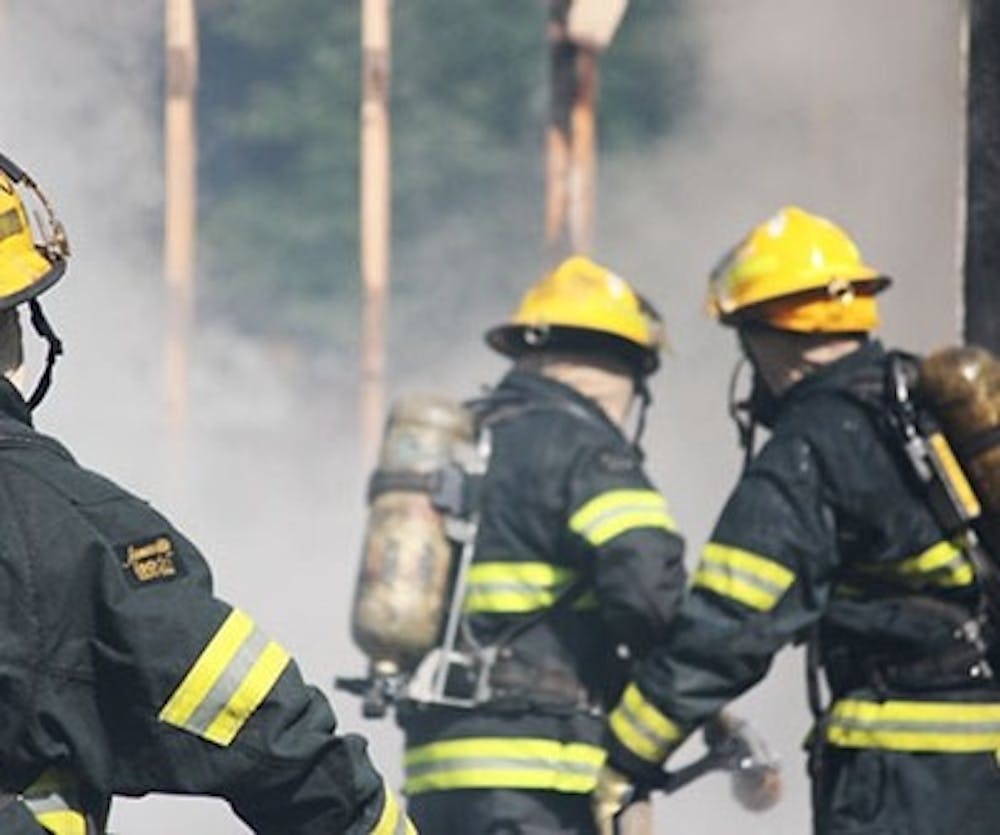
This year’s fire safety demonstration had a clear message: how quickly fires can get out of control.
At Friday’s fire safety demonstration on Hamilton Field, the Division of Public Safety — in conjunction with the Philadelphia Fire Department and the National Fire Sprinkler Association — hosted a live side-by-side burn and sprinkler demonstration to raise awareness about just how quickly a fire can get out of control.
The demonstration on the field between Rodin College House and 40th Street, which was part of DPS’ Campus Fire Safety and Emergency Preparedness Month, was the first ever side-by-side burn on campus.
GALLERY: Campus Fire Safety and Emergency Preparedness Day
At the demonstration, two artificial living rooms — one with a fire sprinkler system built in and one without sprinklers — were lit on fire to demonstrate the difference sprinklers make in containing the flames. Except for the sprinkler system, the two rooms were identical, containing a couch, television, chair, framed picture, newspaper and full garbage can.
John Waters, chief fire marshal of Upper Merion, narrated the scenario as smoke rose from the garbage can in the room on the right — the one without the sprinklers.
After the fire alarm sounds, he began, assuming that somebody calls 911, the operator has 15 seconds to answer the phone. They then have 60 seconds to obtain information before dispatching the call. As the crowd waits during the vital first few minutes, the room is engulfed in flames, and firefighters are still minutes away from being on scene.
Waters explained that fires have been growing faster with new furniture and technology. “It amazes me how much energy there is in a couch and an overstuffed chair. And that’s all we’ve got here, folks.”
By the time the firefighters arrive after six minutes and 45 seconds, the crowd can feel the heat from a distance and see the black smoke up in the clouds. The firefighters use a water hose to attack the flames as quickly as possible, but the damage is clear. The couch is a pile of springs, and the TV is nonexistent.
“So what’s the alternative? Is this what we have to live with?” Waters asked. “The answer is no.”
Immediately after the first fire is put out, a new one begins in the other living room. However, this time there are sprinklers installed. The fire starts spreading the same way as it did before, but soon the sprinklers activate, and the black smoke turns to white. “That’s not smoke, that’s steam,” Waters said. “The sprinkler system is operating here to put that fire out in under a minute. The fire department hasn’t even been dispatched yet.”
In addition to reducing fire damage, the sprinklers also help prevent severe water damage, Waters said. A fire hose sprays about 130 gallons a minute, while the sprinkler system only sprays about 13 gallons a minute, reducing the water damage to one-tenth of its original level.
After the smoke cleared, it was easy to tell which room had the advantage: The one on the right was covered in soot and filled with melted appliances, while the one on the left had some wet, slightly-singed furniture.
Related: Oven fire breaks out at Cosi
Vice President for Public Safety Maureen Rush said that this demonstration helped show “the return on [your] investment when you invest in a sprinkler system.”
“Nothing illustrates [the dangers of a fire more] than seeing visually and feeling the impact of a fire and how quickly it spreads,” Rush said.
Related: Rodin fire causes water damage, evacuation
In addition to the side-by-side burn, DPS hosted a safety fair at which representatives from local and national organizations — such as the Federal Bureau of Investigation and the Philadelphia Office of Emergency Management — had booths with information on safety initiatives they have implemented.
After the demonstration was over, DPS conducted its annual UPennAlert test at 12:15 p.m. by sending a test email and/or text message to members of the Penn community.
The Daily Pennsylvanian is an independent, student-run newspaper. Please consider making a donation to support the coverage that shapes the University. Your generosity ensures a future of strong journalism at Penn.
DonatePlease note All comments are eligible for publication in The Daily Pennsylvanian.





